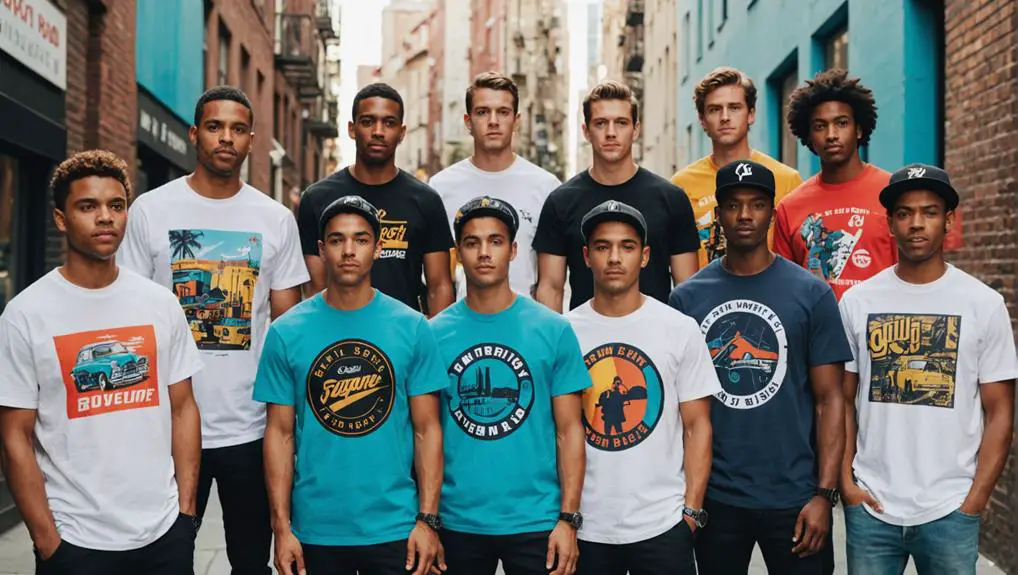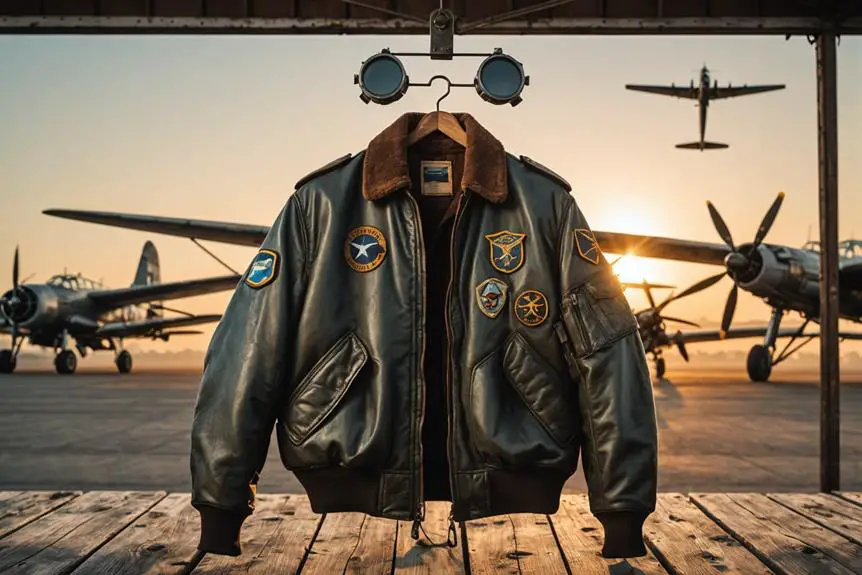In the 2010s, men's t-shirts evolved into vibrant canvases of personal expression and style. Luxury brands like Gucci and Balenciaga heightened the landscape with bold graphics and minimalist designs, transforming tees into luxury items. Fast fashion thrived, offering trendy styles at shocking prices, often reflecting runway hits. Streetwear culture surged, with brands like Supreme elevating graphic tees to status symbols. Football shirts appeared in fashion conversations, highlighting eclectic designs and vibrant colors. As sustainability became essential, eco-friendly tees gained traction too. This decade marked a dynamic shift in how you wore your identity through t-shirts, and there's much more to explore.
Luxury Brand T-Shirts
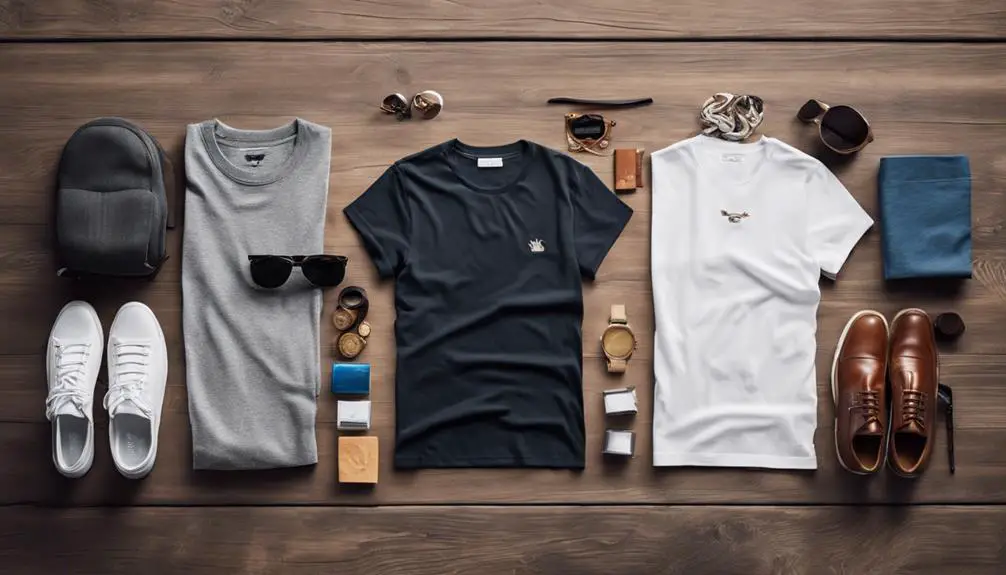
In the 2010s, the allure of luxury brand t-shirts transformed everyday fashion into a statement of identity and prestige. Major players like Valentino, Balenciaga, and Gucci led the charge, enchanting fashionistas with bold graphic designs that screamed exclusivity. You could see how the perception of t-shirts shifted; they evolved from basic casual wear to coveted luxury items, often flaunting a high price point that exceeded £300.
This surge in demand for unique pieces prompted luxury brands to push the envelope, incorporating artistic visuals that made their t-shirts stand out. You weren't just wearing a tee; you were showcasing a work of art. Minimalist graphic and logo designs also carved out a niche, appealing to those who preferred a more understated elegance. These subtle yet sophisticated styles emphasized quality over ostentation, allowing you to express your taste without shouting it.
Navigating this luxurious landscape, you found that every t-shirt told a story, reflecting not just a brand but a lifestyle. Investing in one wasn't just about fashion; it was about owning a piece of the high-end narrative that defined the decade.
Rise of Fast Fashion
The rise of fast fashion in the 2010s revolutionized how you approached t-shirt shopping, making trendy styles accessible at prices that felt almost too good to be true—often as low as a cup of coffee. Fast fashion brands became popular for their ability to churn out t-shirts that mirrored runway trends in record time. You found yourself drawn to the sleek, ever-changing collections, enthusiastically snatching up pieces that seemed to vanish overnight.
However, this convenience came with a hidden cost. T-shirts from these brands often lacked durability, promoting a culture of disposable clothing that raised environmental concerns. You might have justified your purchases with the "price per wear" model, allowing you to buy multiple t-shirts without guilt. But as you filled your wardrobe with these inexpensive items, you couldn't help but wonder if quality was being sacrificed for affordability.
Despite the thrill of staying on-trend, the fast fashion industry shifted your focus towards fleeting fashion statements rather than sustainable choices. As you embraced this new shopping landscape, you navigated the balance between style, cost, and the implications of your choices in a world increasingly driven by speed and trends.
Streetwear Influence
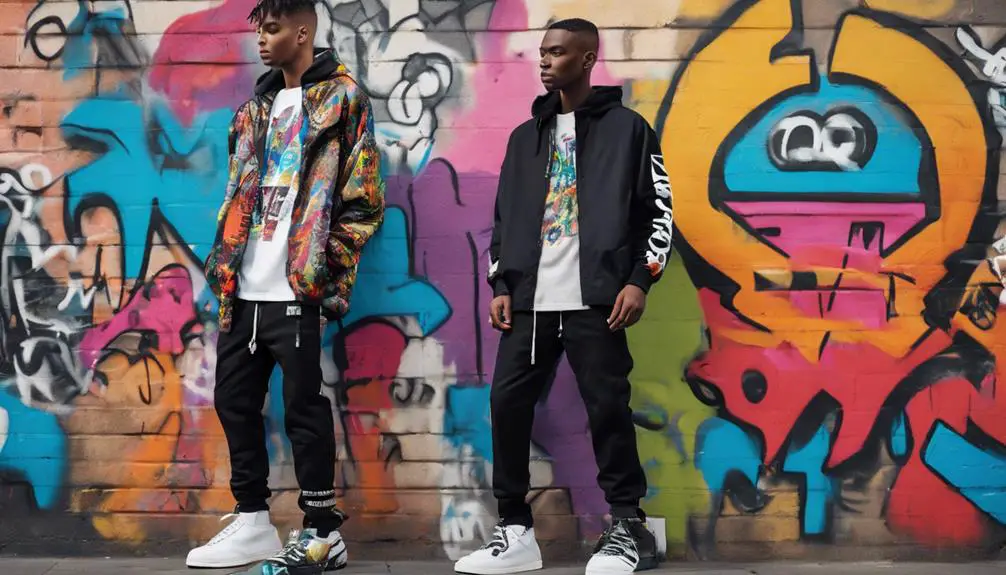
Streetwear culture exploded in the 2010s, transforming how you viewed t-shirts and their role in everyday fashion. As brands like Supreme reached iconic status, the demand for graphic tees surged, elevating what a simple t-shirt could represent.
- Supreme's box logo t-shirt became a symbol of exclusivity and status.
- High-end brands, including Louis Vuitton, started to blur the lines between luxury and streetwear.
- Bold designs and logos on t-shirts appealed to a diverse audience beyond traditional sportswear fans.
The influence of streetwear reshaped the landscape of men's t-shirts, making them a staple in modern menswear. The casual aesthetics of streetwear paired seamlessly with high fashion, leading to collaborations that merged luxury with everyday wear. You couldn't walk down the street without spotting someone flaunting a striking graphic tee, often adorned with renowned logos. This movement not only redefined fashion but also encouraged self-expression through clothing. T-shirts became more than just wardrobe essentials; they became a canvas for creativity and identity. The decade marked a significant evolution, where the humble t-shirt transformed into a powerful statement piece in the ever-evolving world of streetwear.
Football Shirts as Fashion
Football shirts became a surprising fashion staple in the 2010s, enchanting not just die-hard fans but also a diverse audience enthusiastic to embrace their bold designs. As the decade progressed, football shirts shifted from mere sportswear to iconic fashion statements, capturing the attention of trendsetters and streetwear aficionados alike.
The Nigeria 2018 World Cup shirt epitomized this shift, selling out on release day and becoming a cultural phenomenon due to its striking aesthetics. It illustrated how consumers began prioritizing the visual appeal of football shirts, often wearing them as fashion statements, regardless of team allegiance.
High fashion brands took note, leading to collaborations that blurred the lines between sportswear and luxury fashion. You could see runway models strutting in vibrant kits, showcasing how football shirts seamlessly integrated into high-fashion collections.
As this trend evolved, football shirts firmly established themselves in streetwear culture, reflecting a broader acceptance of sports apparel in everyday fashion. With their eclectic designs and vibrant colors, football shirts became not just a nod to athleticism but a celebration of personal style and individual expression.
Minimalist T-Shirt Trends
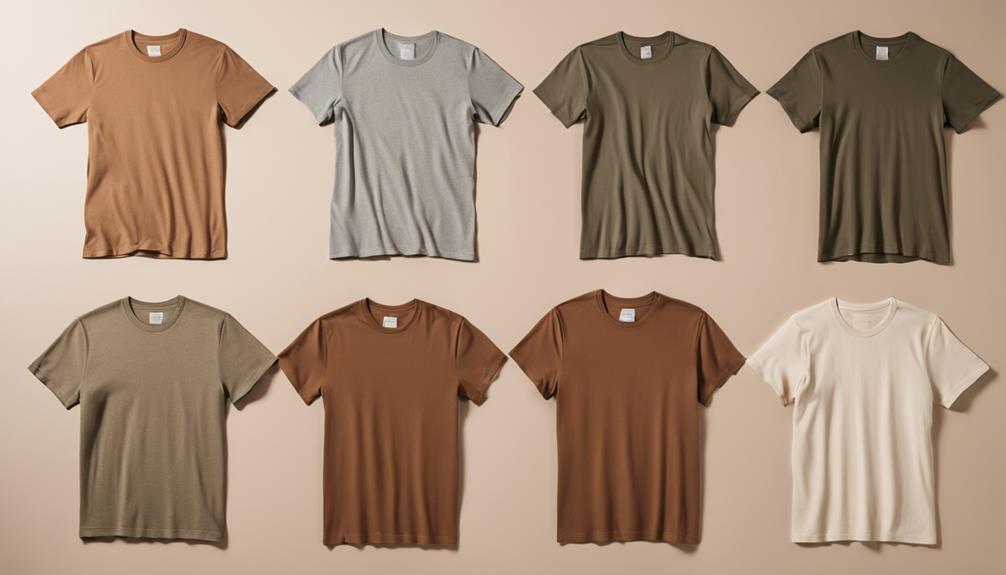
Amidst the vibrant chaos of 2010s fashion, minimalist t-shirt trends emerged as a revitalizing change, entrancing those seeking a sleek and refined aesthetic. You might've noticed how this shift introduced a new vibe in wardrobes, favoring subtlety over loud graphics.
- Emphasis on small logos and understated designs
- High street brands like YSL championing luxe minimalism
- Budget-friendly options making this trend accessible
Fashion became a canvas for simplicity, where minimalist tees took center stage. Gone were the days of oversized graphics; instead, you found yourself drawn to tees that whispered elegance rather than shouted it. High street labels embraced this trend, crafting pieces that seamlessly integrated into both casual and formal looks. Whether paired with tailored trousers or your favorite jeans, these shirts highlighted versatility, making them staples in your collection.
The cultural movement towards functionality and simplicity made it easier for you to express your style without the clutter. With minimalist t-shirts in your wardrobe, you could embody a chic, effortless look that resonated with the zeitgeist of the decade, proving that less truly is more.
Sustainable Fashion Practices
As the 2010s progressed, you likely noticed a significant shift in how fashion was produced and consumed, particularly in men's t-shirts. The late decade brought a surge in consumer awareness about the environmental repercussions of fast fashion, leading you to seek out sustainable fashion practices. Brands responded by highlighting eco-friendly materials, with organic cotton and recycled fabrics becoming essential selling points.
To further embrace sustainability, fair trade practices emerged, guaranteeing that workers received fair wages and worked in safe conditions. This shift encouraged you to favor minimalist designs and timeless styles, focused on longevity rather than fleeting trends. You found comfort in knowing that your choices had a positive impact.
Vintage and thrift shopping gained momentum during this time, with many opting for second-hand men's t-shirts as a stylish and sustainable alternative to new purchases. Here's a quick overview of sustainable fashion practices you might have encountered:
| Practice | Description | Benefits |
|---|---|---|
| Eco-Friendly Materials | Use of organic cotton and recycled fabrics | Reduces waste and promotes sustainability |
| Fair Trade Practices | Guarantees fair wages for workers | Supports ethical labor conditions |
| Minimalist Designs | Focus on timeless, durable styles | Encourages longevity in clothing |
| Second-Hand Shopping | Thrift and vintage finds | Reduces environmental impact |
| Consumer Awareness | Increased demand for sustainability | Influences brand practices |
Cultural and Graphic Expressions

The 2010s marked a vibrant era for men's t-shirts, where cultural and graphic expressions became powerfully intertwined with fashion. You saw graphic t-shirts transform from basic staples into bold statements that reflected identity, lifestyle, and artistry. This decade was all about embracing individuality through unique designs and styles.
- Luxury brands like Balenciaga and Gucci took graphic tees to new heights, featuring artistic graphics that often cost over £300.
- Streetwear culture flourished, with brands like Supreme releasing iconic tees that sold out within minutes, driving a frenzy among fans.
- The minimalist trend emerged, favoring subtle designs over large logos, as seen in YSL's understated tees.
This mix of extravagance and simplicity meant you could express yourself in countless ways. Football shirts also transcended their sporty roots, with Nigeria's 2018 World Cup shirt capturing the fashion world's attention. As you navigated this colorful landscape, environmental consciousness started to shape your choices, leading to a rise in sustainable graphic tee production. You were part of a generation that not only valued aesthetic appeal but also ethical production, making each t-shirt a canvas for cultural dialogue.
Frequently Asked Questions
What Shirts Were Popular in the 2010s?
In the 2010s, you'd've noticed graphic tees, minimalist designs, and luxury logos dominating wardrobes. Streetwear gained momentum with iconic pieces, while sustainable fashion started making waves, reshaping how you viewed casual style and ethical choices.
What Did Guys Wear in the 2010s?
In the 2010s, you rocked graphic tees, minimalist designs, and streetwear staples. Pairing casual pieces with tailored looks, you embraced athleisure while opting for sustainable options, reflecting your stylish yet conscious approach to fashion.
What Brands Were Popular in the 2010s?
In the 2010s, you saw brands like Supreme and Gucci dominate the scene, blending luxury with streetwear. Fast fashion giants like H&M made trendy styles accessible, while minimalist designs offered a refined aesthetic for everyone.
What T-Shirts Were Popular in the 2000s?
In the 2000s, you'd see graphic tees everywhere, flaunting bold logos and slogans. Streetwear brands flourished, while vintage styles made a comeback, allowing you to express your unique interests and personality through custom designs.
